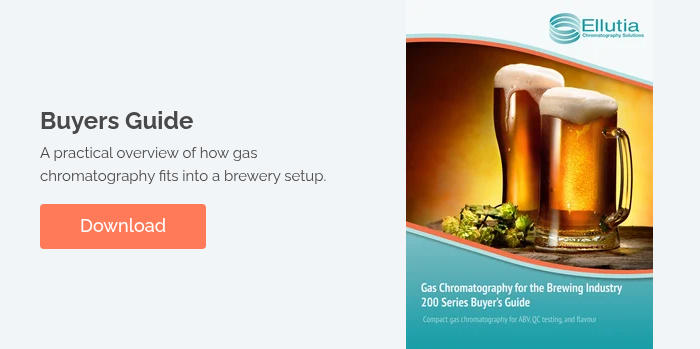Measuring ABV in Cider
Application Note:
ABV testing in cider using gas chromatography.
Introduction
Accurate alcohol measurement is essential in cider production. Even small deviations in %ABV can affect flavour balance, labelling accuracy, and duty calculations.
Traditional methods such as hydrometers and oscillating density meters estimate alcohol from density, but cider’s complex composition makes that approach unreliable. Fruit sugars, acids, and pectins, combined with carbonation and back-sweetening, distort readings and lead to inconsistent results.
Gas chromatography provides a direct way to measure ethanol. It gives fast, accurate, and repeatable %ABV results, helping cider producers confirm label values, avoid delays, and maintain confidence in every batch.

The Challenge
Why traditional methods often falls short in cider testing
Cider’s makeup complicates alcohol measurement. Sugars, acids, polyphenols, and pectin residues all skew density-based readings, especially after back-sweetening or late flavour additions. CO₂ retention further affects volume and temperature corrections, making even well-calibrated hydrometers or density meters unreliable.
Outsourcing ethanol checks to external labs is one alternative, but it adds time and cost. Results often arrive after packaging or shipment, creating potential rework or compliance issues.
Producers need a quick, reliable way to measure ethanol directly, with data they can trust for label accuracy and duty records.

The Solution
Measuring ethanol directly in cider
Gas chromatography separates the compounds in a sample and measures ethanol on its own. The result is a precise, traceable %ABV figure that avoids the uncertainty of density corrections.

With the Ellutia 200 Series GC, cider producers can analyse samples in their own facility within minutes. The instrument provides consistent, repeatable results that support both quality control and duty reporting. On-site testing reduces turnaround time and keeps production flowing.
Gas chromatography separates every compound in the sample. Ethanol is measured independently of sugars, carbonation, or other ingredients, giving a clear and dependable reading every time.
If you’d like a practical overview of how gas chromatography fits into a brewery setup, take a look at the 200 GC Buyers Guide for Breweries.
Method Overview
How cider is tested using gas chromatography
Once the system is calibrated, the workflow is simple. A small sample is prepared, calibration standards are run to build a reference curve, and the instrument measures ethanol directly against that curve.
Before testing, the cider is degassed by gently pouring it between two beakers to remove CO₂. This helps prevent bubbles from interfering with injection. If the sample is cloudy or contains particulates, it can be filtered before analysis.
Calibration standards are prepared using ethanol in water, ranging from 0.01% to 10%. These are used to build the calibration curve for ethanol quantification.
The method uses the following GC conditions:
- Column: EL-5, 30 m × 0.25 mm × 0.25 µm
- Injector: 250 °C, split mode, 0.5 µL injection
- Detector: FID at 300 °C
- Oven program: Start 100 °C (hold 0.1 min), ramp 20 °C/min to 170 °C (hold 1 min)
Watch
How to Prepare Calibration Standards for ABV Testing in Cider
Learn how to prepare ethanol calibration standards for accurate ABV testing in cider. This step-by-step guide shows how to mix and handle standards that form the basis of a reliable calibration curve for GC analysis.
How to Measure ABV in Cider Using Gas Chromatography
Follow the complete process for testing alcohol content in cider using the Ellutia 200 Series GC. This walkthrough demonstrates each stage, from sample injection to data review, showing how to achieve precise %ABV readings and consistent quality control.
Results and Reliability
What the results show
The ethanol calibration from 0.01% to 10.00% v/v produced a linear response with an R² value of 0.9999882, showing stable and consistent detector performance.
A cider sample with a labelled value of 8.4% ABV was tested using this method and measured 8.44% v/v. The chromatogram displayed a clear, baseline-resolved ethanol peak, confirming the accuracy and precision of the analysis.
If you’d like to see the full details behind this testing method, you can download the complete application note. It includes chromatograms, calibration data, and all system parameters used for the analysis. It’s a useful reference if you want to confirm your own setup or compare results.
Learn More
Get the full method and results
If you’d like to see the full details behind this testing method, you can download the complete application note. It includes chromatograms, calibration data, and the exact conditions used for the analysis. It’s a handy reference if you want to check your own setup or compare results.
Download the full application note.
It only takes a few moments to signup.
Frequently Asked Questions
-
How is cider tested for ethanol content?Cider can be tested using gas chromatography. The method separates ethanol from other compounds and measures it directly, giving an accurate %ABV result.
-
Why can density readings be misleading in cider?Cider contains sugars, acids, and CO₂ that alter density, making it difficult to separate the effect of ethanol. Density-based readings often misrepresent actual alcohol levels.
-
Can gas chromatography be used on-site in a brewery?
Yes. Compact systems such as the Ellutia 200 Series GC make it possible to measure ethanol accurately in your own brewery. This removes the need to send samples to external labs and allows faster decision-making before packaging.
-
How long does a gas chromatography test take?Each run typically takes just a few minutes. Once the instrument is calibrated, results can be reviewed almost immediately.
-
What else can the 200 Series GC be used for in brewing?Alongside alcohol-free testing, the same system can be used for flavour profiling and volatile compound analysis, helping brewers control both product quality and consistency.



